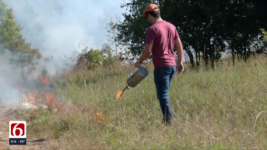
Tulsa Botanic Garden Uses Prescribed Burn To Restore Prairie Land
The Tulsa Botanic Garden intentionally burned 19 acres of land to clear out underbrush and overgrown vegetation just West of the developed garden area.
It’s the first time the Botanic Garden has used prescribed fire to manage its land in the Osage Hills.
“Some prairie plants have roots that go down 12′ into the ground, so burning their top foliage is no big deal,” said Olive Prichard the Curator of the Cross Timbers Nature Trail, “They’re able to regrow and flourish after a fire.”
The work focused on an area around the nature trail, an area of forest and open land with invasive eastern red cedar and winged elm that can spread unnaturally if the property is never burned.
The Botanic Garden has not burned the property in the last 25 years.
Cole Fagen led the operation on behalf of the Oaks & Prairies Joint Venture, a group that helps landowners improve habitat for birds and other wildlife.
“I looked at some 1950’s aerial imagery and this whole south hillside was way open, with very few scattered trees, the way it historically was the way early explorers and settlers documented. Most of the great plains burned on average every 2-4 years and that’s what kept the prairies open back in the day.”
The fire conditions were perfect for a controlled burn, according to Fagen, and the fire cleared out the undergrowth and some larger trees, like honey locusts with thorns that spread through the oaks.
The goal is to clear that to restore the land to the way it was.
“Hopefully in the end we’ll have a very healthy tallgrass prairie system along with an oak forest so we’ll be able to show guests a little bit of the cross timbers,” said Prichard.



